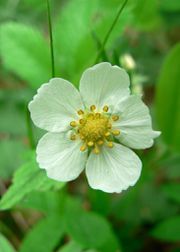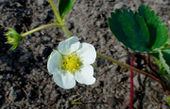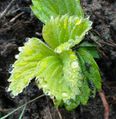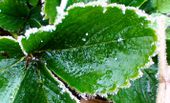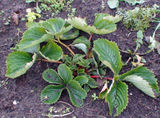Difference between revisions of "Strawberry"
| Line 20: | Line 20: | ||
== Cultivation == | == Cultivation == | ||
| − | [[File:Wild-strawberry-flower - pub dom.jpg| | + | [[File:Wild-strawberry-flower - pub dom.jpg|180px|thumb|left|Flower of wild strawberry]] |
| − | + | The strawberry can be propagated from seeds or by using the new shoots that mature plants make, usually after the plant has given fruit that year. The runners quickly make their own roots and when they have grown big enough, you can select the best ones and give them their own place. <br> | |
Wild strawberries grow mostly on open places in forests, so give your strawberries a sunny place and make sure that the soil is rich of humus. <br> | Wild strawberries grow mostly on open places in forests, so give your strawberries a sunny place and make sure that the soil is rich of humus. <br> | ||
The best time to do this are the first few weeks of August. These plants will give harvest for the two consecutive years, therefore make sure that you renew your strawberry plants each year, for example half of them.<br> | The best time to do this are the first few weeks of August. These plants will give harvest for the two consecutive years, therefore make sure that you renew your strawberry plants each year, for example half of them.<br> | ||
Revision as of 07:09, 19 June 2012
| Garden strawberry | |
|---|---|
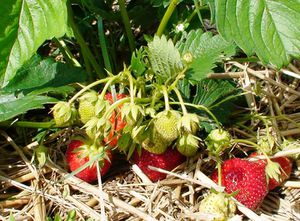
| |
| Strawberry plant with fruits | |
| Scientific classification | |
| Kingdom: | Plantae |
| Order: | Rosales |
| Family: | Rosaceae |
| Subfamily: | Rosoideae |
| Genus: | Fragaria |
| Species: | F. ananassa |
| Binomial name | |
| Fragaria ananassa | |
The most common strawberries grown commercially are cultivars of the garden strawberry, a hybrid species known as Fragaria × ananassa.
Strawberries are not true berries. The fleshy and edible part of the fruit is a receptacle (the thickened part of a stem from which the flower organs grow), and the parts that are sometimes mistakenly called "seeds" are achenes (dry fruits that contain the seed).
Cultivation
The strawberry can be propagated from seeds or by using the new shoots that mature plants make, usually after the plant has given fruit that year. The runners quickly make their own roots and when they have grown big enough, you can select the best ones and give them their own place.
Wild strawberries grow mostly on open places in forests, so give your strawberries a sunny place and make sure that the soil is rich of humus.
The best time to do this are the first few weeks of August. These plants will give harvest for the two consecutive years, therefore make sure that you renew your strawberry plants each year, for example half of them.
The strawberry fruits don't like to come in touch with wet soil. You can protect them by covering the soil around the plants with a layer of mulch, straw or sawdust.
They will reward a rich gift of compost with giving ample fruits, up to a few hundred per plant in each season.
Gardeners distinguish two main types of strawberry: The "June-bearing" strawberries, which bear their fruit in the early summer, and "ever-bearing" strawberries, which often bear several crops of fruit throughout the season.
Medicinal uses
Strawberry is anti-diarrhoeal, diuretic and astringent.
Anti-diarrhoeal
Leaves and roots of wild strawberry are traditionally used as astringent to treat diarrhoea. The astringent activity of wild strawberry is explained by its high content of tannins and proanthocyanidins.[1] A tea made from the leaves is said to check dysentery.[2]
Diuretic
The strawberry fruit is considered to have cooling, calming and diuretic properties. Strawberry fruits and leaves are used to treat urinary tract disorders.
Lower cancer risk
According to Phytochemicals.info
- "cultivated strawberries and phytochemicals from strawberry reduce the risk of cancer. Ellagic acid and isothiocyanates are two phytochemicals which have chemopreventive action. In vitro studies have shown that strawberry extract can reduce cell proliferation of breast cancer cells and colon cancer cells. Consumption of strawberries with meals rich in nitrate and amines can reduce the carcinogenic action of nitrosamines."
Mouth hygiene
The Strawberry is a useful dentifrice and cosmetic. The fresh fruit removes discoloration of the teeth if the juice is allowed to remain on for about five minutes and the teeth are then cleansed with warm water, to which a pinch of bicarbonate of soda has been added.[3] Tea from strawberry leaves can be used as gargle to treat mouth infections.
Gallery
Garden Journal
- December 2011 - This strawberry plant is about half a year old. I planted 100 of these in July. These strawberry plants are a cultivar grown by professional strawberry growers. I've given them a good gift of compost.
See also
References
External links
- Garden strawberry Wikipedia
- Strawberry A Modern Herbal by Mrs M. Grieve
Videos
- How To Build Your Own Strawberry Tower
- HOW TO GROW STRAWBERRIES Carol O'Meara Extension Agent - Horticulture Entomology with Colorado State University shows how to grow strawberries.

